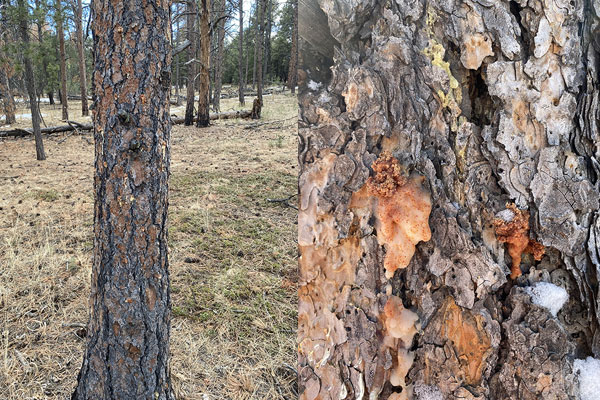
WOODLAND PARK, Colo. – October is an ideal time for landowners to check pine trees, specifically lodgepole, ponderosa and limber, on their property for the presence of mountain pine beetle (MPB). Each year, MPB take flight in late summer to look for new host trees. By October enough time has passed to see signs of infestation, but the weather is often warm and dry enough for outdoor walks.
What to Look For
MPB leave some easy-to-identify signs that they’ve infested a tree. If you see these two diagnostic signs on your trees, you’ll know that MPB have bored into the trees.
- Pitch tubes: These look like popcorn, but they’re actually globs of sap. Sometimes healthy trees can flush beetles out, but if you see multiple pitch tubes or tubes that are red or pink, there’s a good chance that the beetles have successfully infested the tree.
- Frass: Look around the base of the tree and in crevices in the bark. If you see sawdust, it means that the beetles have been boring into the tree’s bark.
Pro Tip: Start your inspection near previously attacked trees. You can recognize them from their dead, orange crowns. MPB are more likely to move into live trees nearby and will not attack dead, previously infested trees.
What to Do Next
After MPB infests a tree, there is really only one best practice: remove the tree. In October, you can mark the trees for removal and make a plan to get them out by next spring. Landowners can either haul the tree out or chip it in place. Just remember, if you’re hauling the infested wood away, make sure you take it outside of the forest, to a site at least 1 mile from susceptible pines.
About Mountain Pine Beetles
Mountain pine beetles (Dendroctonus ponderosae) are native insects to Colorado. In reasonable numbers, they do provide important functions in forests. They can engineer natural forest thinning, killing weak or sick trees, leaving space and nutrients for healthy trees and other organisms. However, forests that are stressed from drought, fire damage or over-crowding allow MPB to thrive and increase their populations exponentially. Healthy, well managed forests are more resistant to MPB outbreaks.
Contact your local Colorado State Forest Service Field Office with questions about the trees on your property.

